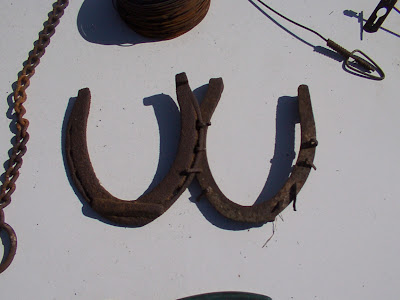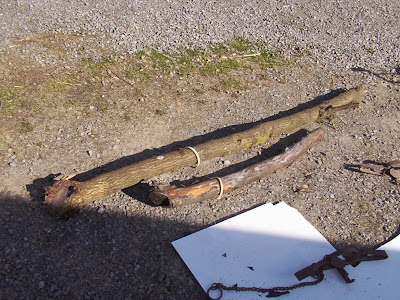These are the times that drags cans save your bacon.
If you set your trap in the open a drag will allow your critter to get out of sight from someone who may take it.
If you set your trap in a rocky area you may not be able to stake or have anything to tie it to. A drag will allow you to set your trap in these places.
When I was a youngster, a person could still trap in Colorado. The Colorado trappers association put on a rendezvous every year. They would always have workshops so everyone could learn new things. I went to every one I could.
At one of these an old trapper (I forget his name) gave a demo on drags.
Up to this point I hadn’t used a drag, but after I went I started using them often and have continued to do so for over 20 years.
The premise of a drag is to allow the animal to move and usually they will head for cover and get tangled up.
It will also allow you to hold a much larger critter than if the trap is staked solid since there is some give when the chain is pulled.

The tools of the trade.
Two logs. The one on the left is 6 ½’ for larger animals, and the one on the right is about 4' for smaller animals.
Two traps. Both are #3 coyote traps but really you can catch about anything in them.
Plain old hardware store wire and a pair of side cutters or lineman’s pliers.
Two snares, a rock and two horseshoes
 Two types of snare swivels.
Two types of snare swivels.The one on the left is a McGregor (my favorite type of snare).
I think they are no longer in business; they were out of Roundup, MT.
The one on the right is a 72 Thompson coyote snare.
Since I don’t use store bought drags I came up with this reasonable facsimile.

It is two old horseshoes. One still had nails and I put them thru two holes on the other and bent them over.

Wired together well with a single wire.
Then a double strand wrapped around and thru the chain loop.
The loop is passing thru four strands of wire.
When using a drag like this be sure to use a longer than normal trap chain.
This is a newhouse trap with a three foot chain. I would consider that a minimum length for good performance. You want the drag to lag behind when the critter turns so it has a better chance of hanging up and the longer the chain the better. In the first photo you see the trap on the left has a five foot chain and was set up for a store bought hook drag.

I hope you don’t plan on getting your trap back wired like this!!

Double wire thru the chain loop.
This is a very common way to wire your trap to a drag.
It will work but in my opinion is not the best way.

Same double wire around the log.
But now I have added another double wire from the chain loop to the log wire.
This gives you a very good pivot point and allows the log more movement while being drug around.

Here is another very good set up.
If there is a chance your wire could slip off the end of the log, this is the way to go.
A long length of double wire is wrapped around the log, twisted tight, then laid down the log a few inches and wrapped around again.
Then it is tied off.
Then take the short double wire and put it thru the horizontal wire and tie it off.
The next picture shows this hooked to a snare.
Please note that in most if not all places, it is illegal to use a drag with a snare. I include this so you can see how to hold big animals in a survival situation.

This set up with a 72 Thompson snare tied to a 6' pole about 3 dia. held a mountain lion thru 3 hangups.
In each of the hangups the lion cleared a 10-15 foot circle in sage brush.The cable finally gave way.
It was set for coyotes on a trail beside some beaver ponds where we had some sets.
At that time there wasn’t a mandatory check time using killer type traps (connibares, snares and drowning setups) so we checked them once a week. From the tracks it looked like it held for quite a while. I’m more responsible today and in a TSHTF situation checking sets will be a daily exercise.
 I used romex to mark the best place to tie off.
I used romex to mark the best place to tie off.Usually you will want to tie off between 1/4 and 1/3 down the length of the drag . This way the drag runs semi- parallel to the direction of travel and when it catches it will absorb some of the shock as the log springs out sideways.
To use a rock....
 I picked a round rock to show a worse case. Try to pick one with flatter sides if possible.
I picked a round rock to show a worse case. Try to pick one with flatter sides if possible.First make a cradle by taking a long single strand of wire and placing the rock in the middle of it then wrap the wire around to meet on the other side and twist the two together one or two times.
Then go back around in two different places and twist the wire where it meets on the original side then again back around again in a third place and tie off.
It should look something like the picture....
Then take a double wire and tie your chain be sure and go under all 3 wires.
Still clinging to my God and my guns,
Randy
